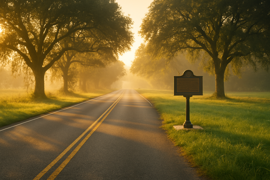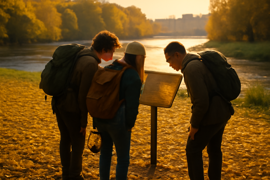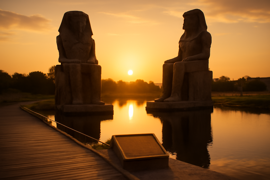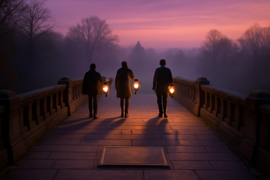Recognized Folklore Landmarks: Official Markers of America's Mythic Heritage
Reading Time: 11 min

About Story: Recognized Folklore Landmarks: Official Markers of America's Mythic Heritage is a Legend Stories from united-states set in the Contemporary Stories. This Descriptive Stories tale explores themes of Wisdom Stories and is suitable for All Ages Stories. It offers Cultural Stories insights. Exploring roadside plaques and statues that turn U.S. legends into officially recognized destinations.
Introduction
From the misty bayous of Louisiana to the fog-fringed lighthouses of Maine, the United States has begun pinning its unofficial memory to the map with very official hardware: folklore landmark markers. These burnished plaques, cast-iron silhouettes, and storybook statues invite travelers to pull off the highway and touch the narrative grain of the land. A century ago the National Park Service catalogued battlefield monuments; today state humanities councils are quietly installing roadside signposts that immortalize witches, giants, river spirits, and phantom riders. Each is placed after lengthy research and public debate, then unveiled with speeches that mingle civic pride and childhood wonder. The result is a new, drive-through museum without walls, curated by historians and dreamers who believe myth belongs beside marble. This chronicle follows three emblematic stops on that growing circuit — a haunted cave in rural Tennessee, a lumberjack’s clear-sky footpath in the upper Midwest, and a storied stone bridge in the Hudson Valley. By tracing how these legends won metal nameplates we glimpse the forces that shape American identity, the tourism dollars that shore up small towns, and the restless need of every generation to see its secrets officially recognized before the next call of the open road. It also asks a quieter question: when a myth earns a GPS coordinate, does it gain permanence or lose the shimmer that kept it half-seen? Step off the asphalt and decide for yourself, postcard in hand and the engine ticking cool behind you, as the first marker comes into view.
Southern Tales Engraved in Bronze: The Bell Witch Cave Marker
In the quiet farming town of Adams, Tennessee, the Bell Witch tale once floated over corn rows the way red-winged blackbirds do at harvest. Locals whispered that in 1817 a hostile spirit targeted the Bell family, knocking on walls, hurling objects, and delivering sermons in a voice rough as snapped twigs. Over time camp-meeting preachers, newspapermen, and traveling mesmerists embroidered the account until the cave on the Bells’ land became a kind of shadow cathedral. Tourists arrived on muddy wagon tracks, carrying kerosene lanterns and dime novels. When automobiles replaced mules, the cave was relegated to Halloween features and the occasional college thesis. Yet the legend never truly left; it hid in schoolyard dares and fire-circle retellings, awaiting a chance to surface in daylight.

That chance came in 2014, when the Tennessee Historical Commission convened a public hearing to decide whether a folklore site merited the same brown metal sign that marks Civil War skirmishes. The meeting drew farmers in feed-store caps, professors clutching oral-history transcripts, and a pair of teenagers livestreaming from cracked phones. After three hours of testimony, the panel voted unanimously to install Marker 3A 237: THE BELL WITCH LEGEND. The wording was vetted by archivists and local descendants for balance, acknowledging both the documented harassment of the Bell family and the story’s influence on American paranormal lore. On dedication day a brass band played Rocky Top as volunteers tied red satin ribbon around a cedar post. When the cloth fell away, the marker gleamed in the late-morning sun, its serif letters granting governmental weight to an invisible adversary. Reporters noted that the cave’s new GPS tag pushed visitation numbers up sixty percent within a year, injecting fresh cash into the town’s single diner and two-pump gas station.
But numbers tell only part of the shift. Residents began speaking of the witch with a cautious pride, as though an unruly cousin had finally been invited to the family portrait. Teachers folded the legend into state-history units; genealogists traced witness affidavits; craft brewers released Bell Witch Lager with a label that changes color in moonlight. Critics warned of exploiting fear for profit, yet the wider consensus was that the marker preserved a regional identity too often paved over by chain stores. Standing before the plaque one hears cicadas, smells limestone water seeping from the cave mouth, and senses that something intangible has crossed a threshold into civic memory. Whether the apparition was ever real seems secondary to the fact that the state has, in effect, shaken her hand.
Late each October, the humanities council hosts a lantern-lit walk from the old mill to the cave entrance. Guides pause by the sign to read its inscription aloud, letting the words drift toward the river where John Bell once felled his final crop. The ritual feels half academic conference, half séance, and wholly modern American folklore — a negotiation between scholarship and thrill that echoes along cedar trunks until a volunteer blows out the torch and invites the crowd to imagine the darkness speaking back.
Crucially, the marker’s QR code links to a living archive where visitors can upload personal accounts. Within months, audio files spanned dialects and decades, from a 1950s transistor recording of poltergeist knocks to a 2020 podcast excerpt featuring skeptical hosts. The commission moderates the entries but rarely rejects them, preferring a quilt of voices to a single narrative. In this, the Bell Witch sign functions less as a period on a sentence than as an ellipsis, granting future storytellers room to continue.
Lumberjack Myths on the Open Road: Paul Bunyan’s Trail of Statues
In the northern latitudes where the Mississippi still resembles a skipping-stone creek, a colossal figure keeps watch in fiberglass: Paul Bunyan, shoulders broad enough to ferry sunrise. His genesis can be traced to logging camps of the late nineteenth century, where exaggeration dulled the ache of saw and snow. Over the years admen borrowed the lumberjack to sell everything from pancake mix to chain saws, inflating him to a national folk hero as boundless as the forests he cleared. Today more than forty roadside statues of Bunyan — some with articulated arms, others sporting seasonal scarves — dot a zigzag path from Bangor, Maine, to Klamath, California. It was along this path that state officials first considered whether a corporate-tinged legend deserved codification in bronze.

The campaign began in Bemidji, Minnesota, home to the oldest surviving Paul Bunyan and Babe the Blue Ox statues. Local tourism board members argued that the pair had transitioned from commercial gimmick to cultural signifier, drawing half a million visitors annually. The Minnesota Historic Sites Act required evidence of enduring folkloric significance, prompting archivists to scour campfire songbooks, Works Progress Administration interviews, and early cartoons. Academics highlighted how Bunyan reflected immigrant labor narratives, his axe strokes echoing Scandinavian sagas and French-Canadian chanson. Their dossier convinced lawmakers, and in 2016 Marker 11K 512 — PAUL BUNYAN LEGEND — was erected beside Lake Bemidji. The plaque’s text balanced whimsy with scholarship, noting both the tall-tale motifs and the debate around timber exploitation.
Once the Minnesota sign went up, other states hurried to follow. Wisconsin placed a cast-iron placard outside the Rhinelander lumber museum; Oregon installed a sleek stainless panel near the Umpqua National Forest. An interstate consortium informally dubbed The Bunyan Brotherhood standardised wording to prevent boosterism from eclipsing folklore. QR codes link to a shared database where schoolchildren upload video projects, and where environmental groups post counter-narratives about deforestation. The result is a living palimpsest: each marker is a local handshake, yet all feed a continental conversation on labor, land, and legend.
Economic metrics tell an upbeat story: after Bemidji’s dedication, winter hotel occupancy increased ten percent, and a once-shuttering diner repainted itself in Bunyan plaid. Less tangible but equally potent is the civic confidence that springs from having a giant for a neighbor. High-school basketball teams adopt ox-horn logos; literacy drives give away blue notebooks stamped Tall Tales Start Here; a regional airline christens its new craft Babe One, inviting passengers to ride the legend. Critics worry that commodification may ossify the myth, yet fans counter that growth feeds reinvention. Every year, sculptors debut a new Bunyan pose — swinging an axe, casting a fishing line, or holding a solar panel — and the markers adapt, appending fresh QR entries instead of recasting metal.
Underlying the spectacle is a quieter negotiation between truth and imagination. By affixing official seals to Bunyan’s story, the states do not claim he walked among white pines; they affirm that a shared fiction can shape real terrain. The markers remind travelers that highways are narrative threads, connecting episodes etched in folk memory. When snow muffles engine noise and the statue’s shadow stretches over frozen lake water, the legend feels plausible enough to warm gloved hands. That comfort — part nostalgia, part aspiration — is what lawmakers ultimately endorsed when they bolted Bunyan’s legend into the ground.
Hudson Valley Shadows: The Headless Horseman’s Bridge Plaque
Along the sycamore-lined road that curves into Sleepy Hollow, New York, a discreet stone arch crosses a stream so narrow one could step over it. In 1820 Washington Irving christened it the spot where Ichabod Crane lost both horse and dignity to a headless pursuer, and ever since the village has worn the tale like a snug cloak. For decades the bridge was rebuilt, widened, even briefly removed, its original timbers sold as souvenirs. Yet children still hushed their voices when pedaling past at dusk, and motorists tapped brakes, as if the legend were a traffic law.

In 2020, the bicentennial of Irving’s story, the New York State Office of Parks, Recreation and Historic Preservation faced petitions to install an interpretive marker. Preservationists argued that the site, though altered, remained a locus of intangible heritage. Opponents feared commercial overkill, pointing to Halloween crowds already clogging village streets. The deciding committee, chaired remotely during a pandemic, sifted through zoom testimonies: folklorists citing Dutch colonial roots, descendants recounting family yarns, librarians showcasing first-edition engravings. The compromise was a low-profile bronze plaque set on a basalt plinth, its patina designed to darken like old saddle leather. Marker 14D 888 — LEGEND OF THE HEADLESS HORSEMAN — was unveiled on October 31, 2020, streamed worldwide to costumed viewers who toasted with pumpkin-spiced coffee.
The plaque’s text is spare, inviting rather than instructing: it quotes Irving, lists local place names, and ends with a challenge to listen for hoofbeats on fallen leaves. At night, discreet uplights cast silhouettes of galloping hooves across the stream, a municipal artist’s subtle flourish. The bridge, once an unremarkable commuter notch, has become a theatrical threshold. Visitors time their selfies with the lighting loop, and audio guides broadcast ambient clops and distant laughter recorded by drama students. Yet village elders maintain that the most authentic moment arrives after midnight, when the lights shut off and the water resumes its hush.
The marker’s presence has also spurred scholarship. Sleepy Hollow High now offers an elective on Hudson Valley lore, culminating in students presenting research at the plaque each spring. Tourism revenue underwrites cemetery restorations and a bilingual archive project bridging English and Spanish retellings. Perhaps most telling is how the marker has recalibrated fear into fellowship: on All Hallows’ Eve the local PTA hosts a lantern parade that ends at the plaque, where parents read passages by smartphone glow while children in glow-stick collars picture the rider waiting just beyond the treeline. Official recognition, it seems, has not tamed the legend; it has given it a formal address from which to ride.
Curators continue to debate wording tweaks, proof that the plaque is a living document. Each revision reinforces the idea that myths, like rivers, change course yet keep their source. And though the horseman’s visage remains famously absent, the marker provides a fixed gaze for the legend, anchoring it to stone so the imagination can gallop freely.
Conclusion
Taken together, these markers illustrate a nation discovering that folklore is infrastructure as vital as asphalt. By investing in narrative signposts, states safeguard more than stories; they guard the imaginative commons where citizens test values, laugh at giants, and face fears under streetlights. The plaques lend legislative credence to hauntings and hyperbole, but they also invite perpetual revision through QR archives and yearly festivals. Travelers leaving the Bell Witch Cave, steering north toward Bunyan’s ox and east to Sleepy Hollow, undertake a pilgrimage stitched by bronze, discovering regional accents of the same ancestral impulse: to brand memory into matter before it drifts away. In a country united by roads yet divided by headlines, these small metal squares offer a shared reading list, encouraging families to exit the interstate, idle among cottonwoods or snowbanks, and read aloud a paragraph that ends in ellipsis. The asphalt will still be there when they return to the wheel, but for a moment they will have stepped into the story that was already steering them.

















